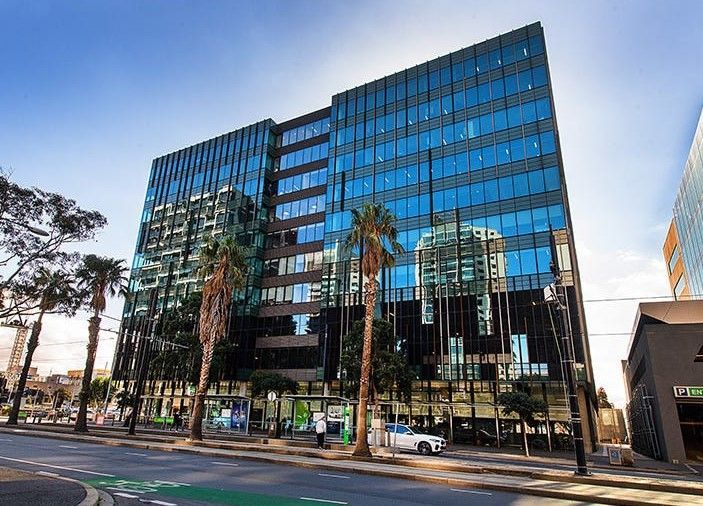Solving workplace parking problems: The ultimate guide

Table of contents:
- The cost of staff parking for workplaces
- The cost of staff parking for employees
- Leasing parking space
- Empty parks = wasted real estate
- The administrative cost of parking
- Traditional systems for managing workplace parking
- Allocated parking
- First come, first served
- Common parking solutions
- Solution: Parking management software
- Solution: Lease additional parking stalls
- Solution: Encourage other forms of transport
- Solution: Carpooling
Staff parking is an important perk for your team that also provides a number of business benefits. The ability to easily park onsite creates a better commute - which is linked to improved wellbeing, productivity, engagement and retention. Happy, healthy, productive staff? Yes, please.
The human, financial, and administrative costs of staff parking
Despite its importance, workplace parking all too often gets tied up in problems and complaints. Here are a few examples:
- Staff complain about the parking. That could look like: working parents can never secure a park onsite and arrive late after circling the block; staff arrive at work two hours early just to park, then sleep in their car; people park at expensive, far away car parks - only to see empty parks at work.
- Parks sit empty, even when there’s high demand for parking. This means expensive real estate is going to waste. It could be because: your parks are allocated to execs or certain staff members who aren’t always in the office, and no one else can park there. This problem has grown massively with remote and flexible working post-Covid.
- Your admin team spends a huge amount of time monitoring the parking lot. This could include: checking if only registered cars are parked, using spreadsheets to keep track of parking, or reconciling parking payments every month.
To further complicate matters, there are a few different business objectives related to workplace parking, which can be in conflict.
Staff engagement - For CEOs, HR, and managers, staff parking is an important component in staff happiness. An easier commute increases engagement and productivity, and helps with talent retention and acquisition.
Financial concerns - CFOs and Finance don’t want to spend more than they need to on parking, in terms of both lease costs and administrative costs. They also want to ensure that what the business pays for is being used efficiently.
Environmental policies - Sustainability Managers may want to reduce the number of staff driving to work, which could mean implementing carpooling bays, EV charger parks, or reducing the number of parking spots available to the team.

The employee cost
There’s plenty of research about how commuting affects health, happiness, workplace engagement, and retention. Some of the conclusions are pretty damning:
- Princeton University found that of all activities, the commute to and from work are two of the most negative experiences of the day
- Commuting is the second-most common source of workplace stress
- The commute is the third largest reason for people choosing to leave a job
Unhappy employees and high turnover are not what companies want. While companies can’t influence much of their employees’ commute, a big part of the problem is parking - and staff parking is largely within a company’s control.
Looking for some real-life examples? Check out how companies like Carsales, Aurecon and IAG have created better commutes and happier employees through changes to their staff parking.
The car park lease cost
On average, 12% of a company’s real estate spend is on parking spaces. This is what that looks like in a few major cities:
- Auckland: In the CBD, businesses easily spend $300 per month on each leased parking spot - that’s over $3,500 per park, per year.
- Sydney and Melbourne: In the CBD, it easily costs $550 per month to lease a parking spot - that’s $6,500 per park, per year.
- London: In the city, you can spend £300 per month on a parking spot - £3,500 each year.
Prior to Covid-19 and the widespread adoption of flexible and remote working, the average company car park saw 20-35% of its parking spots sitting empty every workday. Now, we’ve seen car parks up to 57% empty as more staff work from home.
Empty parks = wasted real estate spend
If a company leases 100 staff parking spots and 33 of their parks sit empty during the year, they are effectively spending over $100,000 dollars or pounds each annum on a vacant asset. By city, that’s a wasted spend of:
- Auckland: $118,800
- Sydney and Melbourne: $217,800
- London: £118,000
This doesn’t mean that companies shouldn’t spend money on staff parking. As we’ve seen, onsite parking can make a big difference to staff engagement. However, it does mean that there’s sound financial reason to use car parks more efficiently - rather than letting them sit empty.
What an example? Check out how Datacom increased their car park occupancy by 15% through a smart parking management system.

The administrative cost
For some businesses and organisations, administrating the car park can be hugely time-consuming and complex.
At Parkable, we’ve heard it all:
- Companies whose facilities managers manually check the parked cars every morning, to make sure they have the correct workplace ID on the dashboard
- Companies whose staff need to sign in at reception whenever they park onsite
- Companies whose finance team needs to calculate parking costs as a deduction to their pay cheque each fortnight
- Companies whose staff call them after hours, before work, and on weekends asking if parking will be available the next day
- Companies whose staff sneak into the car park and use the executives’ allocated car parks, because the other alternatives are so scarce - leaving administrators to clean up the mess
All of these issues drain time and resources, and distract your admin team from more valuable tasks. However, the root problem is always the same: manual systems for monitoring, booking, and payment. With a parking management system, each of these tasks is automated, saving the admin team time and resources.
For example, TAB saved 670 hours of administrative time each year by automating their processes with parking management software.
Traditional systems for managing staff parking
Traditionally, there are two common ways to manage staff parking: allocation, and first come, first served. Here’s a quick overview of each system, the problems, and what companies can do about it.
Allocated parking
An allocated parking system describes a car park setup where each parking spot is assigned to a specific member of staff. Sometimes an allocated park is part of the employee’s contract, and is paid for by the company. In other cases, staff pay an annual salary sacrifice for their park, effectively offsetting the business cost of leasing the car park.
Generally, parks are allocated based on one of two things:
- Seniority - executives or managers receive a parking spot as part of their employment contract
- Length of employment - employees go on a waitlist until a parking spot becomes available, which can take years
Because companies usually have far more employees than parking spots, staff members who do not have an allocated parking spot are left to fend for themselves.

The problem with allocated parking
The major issue with an allocated parking system is that staff are not always in the office. When you take into account remote working, sick leave, holidays, and alternative transport, each employee only actually drives into work and uses their allocated park about 70% of the time.
Because of this, about 30% of staff car parks sit empty each working day. Since Covid-19, these numbers have increased hugely for companies with flexible working policies.
An underused car park has a financial and human cost:
- For staff without an allocated park: When people have to park far from the office or use expensive commercial parking, then see empty parks at the office, it can cause them to disengage and become resentful.
- For business costs: Companies end up paying hundreds of thousands of dollars every year for space that sits vacant because it isn’t used efficiently.
- For businesses with flexible working: If staff pay a salary sacrifice for their allocated park but start working remotely more often, they may no longer see the value in paying for a parking spot and drop their allocation. If this happens on a large scale, businesses are suddenly footing the bill for empty space.
Solution: Sharing space between employees
For these reasons, companies like Tonkin + Taylor transitioned away from an allocated parking system when they went to flexible working, and instead use Parkable to share space between all of their staff.
If you want to retain allocated parking as a perk for specific staff while utilising those allocated parks when they sit empty, a ‘park sharing’ system gives you the best of both worlds, allowing staff to share their park with colleagues whenever they’re away from the office.

First come, first served
The traditional alternative to allocated parking is a ‘first come, first served’ system. Basically, whoever turns up first gets to park, and if you’re too late, you miss out. Although this is generally seen as more democratic than allocated parking, because all members of staff have the right to park onsite, there are problematic biases at play when you look at who is actually benefiting.
Consider these two employees:
- Sarah, who lives 45 minutes’ drive from the office and needs to drop her children at school before work each day.
- Dan, who lives close to the office and doesn’t have responsibilities before the workday begins.
In a ‘first come, first served’ system, it’s easy for Dan to get to work early enough to secure a parking spot, whereas someone like Sarah will always miss out because she has responsibilities that are outside of her control. Over time, Sarah will grow resentful - especially if off site parking is scarce, far from the office, or expensive.
Similarly, this system can incentivise behaviour like staff turning up at work hours early and then eating breakfast or napping in their cars, which is not generally seen as the epitome of ‘work-life balance’.
In short, ‘first come, first served’ benefits some members of your team while being disadvantageous to others - just like an allocation system.
An alternative is to make your car park bookable. This makes the opportunity to park onsite more fairly spread, and removes the need for staff to turn up unnecessarily early. For companies which charge an hourly or daily rate for staff parking, a booking system that also handles payment can significantly simplify car park administration.
A bit of both
Other companies combine these two systems, with some parking spots allocated and others available to all staff on a ‘first come, first served’ basis. While this may appear to be a good ‘middle ground’, many of the problems remain - challenging administration, allocated parks sitting vacant, parking creating a need to arrive at work early, and working parents who never get a chance to use the car park.
Solutions to workplace parking problems
There are a few ways to solve parking problems. If your existing car parks aren’t being used efficiently, as is the case with the grand majority of workplace car parks, a smart parking management system is likely the best solution. Similarly, if time-consuming car park administration is on your mind, a system that automates payment and monitoring can do wonders.
However, if car parks are being used efficiently and you still have a problem, the solution may lie in either increasing the supply (leasing more parking spots) or reducing the demand (encouraging staff to use alternative transport or carpool). Here we’ll cover each of these options.
Implement a parking management system
Car park management software can be used to optimise and share your parking space. Instead of allocated car parks sitting empty when the owner is away from the office, software like Parkable enables the sharing of those parks among the team. For those without an allocated park, Parkable makes the car park bookable, so everyone has a fair chance to park onsite.

What does a parking management system look like?
Parkable’s parking management software includes an admin panel and an app for parkers, plus integrations with EV chargers, access barriers and gates.
Admin teams use the Parkable admin panel to manage the car park. Through the admin panel, administrators can:
- Invite staff or tenants to the car park
- Assign parking privileges to individuals or groups
- Track real-time car park occupancy
- Manage car parks at multiple locations
- Monitor and respond to reported issues
Staff use the Parkable app to park. With the app, staff can…
- Book a park in advance
- Check real-time availability of the car park
- Share their allocated park with colleagues
- Seamlessly pay for parking
By knowing in advance whether they have a park or not, staff can commute with confidence - and without stress - and plan alternative transport when needed.
Want to see how real companies benefit from Parkable’s parking management system? Check out the case studies or book a quick demo with our friendly team.
Lease additional parking stalls
Sometimes, you’re using your car park as efficiently as possible, but still have demand for parking that far exceeds your supply. If this is causing problems for your staff and business, it may be worthwhile investing in leasing additional parking space.
A number of Parkable’s clients, including Masterpet in Sydney and European Motor Distributors in Auckland, use Parkable’s marketplace to lease additional parking space for their staff.
Alternative transport
If you want to reduce driven commutes to take the pressure off the car park (and lessen your company’s environmental impact), you may want to promote alternative transport. This includes public transport, cycling, running, and walking.

Here are a few steps to follow to make your alternative transport campaign a success:
- Send out a survey to learn how your team gets to work, what alternative transport options are available to them, and what prevents drivers from using alternative transport.
- Draw up a travel plan based on the results. The aim is to effectively engage staff, so consider fun ways to get people involved, financial incentives, and how to make alternative transport convenient and easy. Here are some ideas:
- Public transport: Use workplace newsletters, noticeboards, and team meetings to promote awareness about the availability and benefits of public transport. Allowing for more flexible start and finish times can also enable more people to take public transport, so they can plan their day according to the bus or train timetable.
- Cycling: To jump-start some cycling enthusiasm, consider signing up your workplace to a local cycling challenge. For long-term success, make sure to provide free, secure bike storage at work, as well as changing rooms and showers - also important for walkers and runners! To learn (a lot) more about promoting cycle commutes, click here.
See how well your initiatives are going by tracking uptake and conducting follow-up surveys. Make adjustments if need be.
Carpooling
Another great way to have less cars coming into work is by introducing a staff carpooling system. Here are a few tips for successful carpooling:
- Facilitate: Set up a private Facebook group or shared Google doc so that people can organise their carpooling, and you can keep tabs on who’s taking part. You can also look into ride-share apps like Kapuddle in Australia and the Smart Travel app in New Zealand.
- Incentivise: A great incentive for carpooling is to section off part of your car park as ‘carpool only’ bays. Just like T2 or T3 transit lanes, you’re letting people know that there’s an extra benefit to sharing their ride. Another incentive is free or discounted onsite parking for carpoolers.
- Inform: The success of a carpooling scheme hinges upon informing people and getting them onboard. If you have all-staff meetings or gatherings, make sure it’s on the agenda.
Have we missed anything? We want this ultimate guide to be truly ultimate - so if you have any questions that weren’t covered here, please get in touch!
Suggested articles
Solve your parking problems
If you have workplace parking spots and want to...
- Improve employee parking experiences
- Reduce car park admin
- Make better use of your space
- Align your parking with a flexible working culture
- Implement hardware solutions
...feel free to get in touch!
 Blog
Blog